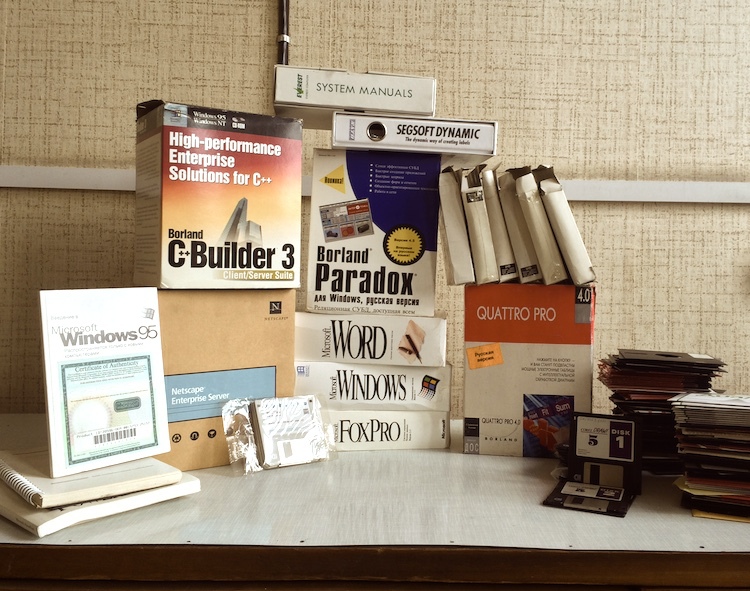IT artifacts of our back room

It so happened that at the moment I am working in a distant Siberian town, on a huge BrAZ . I will not say that it is better here than in Thailand or in some London, but there are also enough miracles, for example, 40 degrees of heat in summer and stable -45 degrees of frost in winter. The local IT department, which survived the BESMs, the buckets of alcohol allocated for their service, deserves a separate story, and is now entertained by eating cakes served on punched cards that colleagues bring to their birthdays.
Of course, the entire IT infrastructure was constantly evolving, and the plant acquired the latest software at that time in beautiful large boxes. When I first saw them, I immediately wanted to delve into them, to see what was inside, how to touch it, albeit a small, but still part of computer history. Recently I had a chance to take photos of them. If you are interested in seeing how software companies spread their programs in the recent past and see for themselves who first realized the idea of server-side JavaScript, then I invite you to search through these boxes with me.
I confess right away that the contents of the boxes from Builder and Paradox could not be found, but at the end of the post you will find a scattering of real 5-inch floppy disks with the hell out of it.
')
So let's start with the first box.
Borland's quattro Pro 4 spreadsheet editor is a former competitor to Novell Lotus 1-2-3, which were subsequently pushed out of the Microsoft Excel market. At the moment, I joined the office suite from Corel (yes, there is one).
The distribution kit spread on 5-inch floppy disks, with which anything could happen. In order to reduce the likelihood of damage, they were placed in a cardboard case.
I doubted a little whether to upload this photo, but, judge for yourself, this is a license agreement from a major developer (at that time) and on just 1 A4 sheet.
The next box is Netscape Enterprise Server.
Netscape Enterprise Server - the web server from the company, actually, Netscape. Subsequently became the product of Sun, which in turn opened its source codes in 2008. Only the manuals remained in the box, but which ones.
Netscape was the first to introduce the concept of Javascript applications running on the server side. This is understandable, because it was at that time (1997) that the Netscape was driving the web.
Next comes Microsoft software.
When I opened the box from Microsoft Word 2.0, the impression was that they almost did not use it, the kit and floppy disks were so well preserved.
Microsoft Windows 3.1 "For the first time in Russian!" Apparently was the entrance, there was no diskette included.
Microsoft FoxPro DBMS. Unlike Word, the contents of the box were visible - the system was used. The manual for the program was carefully wrapped in tracing paper, and the pages showed signs of spilled tea. Some of you know that at the time FoxPro was fairly common, and in 1992, Microsoft bought the developer of this product for $ 173 million.
Software and manuals that came with a thermal printer. Great box. Interesting fact, the technical specifications of the printer are filled in manually in the special columns of the table.
Documentation kit from PC Everest. The structure includes a small user manual with a story about how to use the mouse and keyboard, information about the motherboard, driver diskettes.

I found the PC Magazine magazine of 1989 on the Web, with a description of its characteristics in an article about PCs in the lower price range. At that time, it cost 2990 dollars.
All the boxes ran out. There are still a few floppy disks, one book and device.
Legendary vector editor Corel Draw on 14 diskettes. Appearance is good, but it is unlikely that they can be read.
System canoe. The driver for working with the InterBase database from the old version of the BDE Engine , whose architecture in 2000 was transferred from SQL Links technology to dbExpress.
Introduction to Microsoft Windows 95. Got into the compilation just because of its Certificate of Authenticity. I just like such things - there is still somewhere a licensed Windows 2000 Professional CD with a holographic sticker on the entire disc. Honorable
But the promised pile of floppy disks. Nobody knows what was there, but the signatures scrawled with a pencil indicate that some archives were kept there. Note (I swear it is) a lot of 2HD floppies and it's really cool - 1213952 bytes after formatting!
Still preserved such a device - "sticker". Served as write protection for standard five-inch floppy disks (unused stickers in the photo are on yellow paper).
Well, dear friends, the tour has come to an end. All that could be found in a pile of our rubbish, I showed. I hope you were interested, and you learned something new for yourself.
In general, as usual, put likes / dislikes, all good and Fridays.
Source: https://habr.com/ru/post/238997/
All Articles